This collection of traditional German Christmas cookies combines rich flavors and textures to bring the festive spirit into your home. Each recipe features unique tastes of German holiday traditions, from the nutty and chocolatey Nussecken to the spicy and sweet Lebkuchen. These German Christmas cookies are perfect for adding a touch of international flair to your holiday baking.
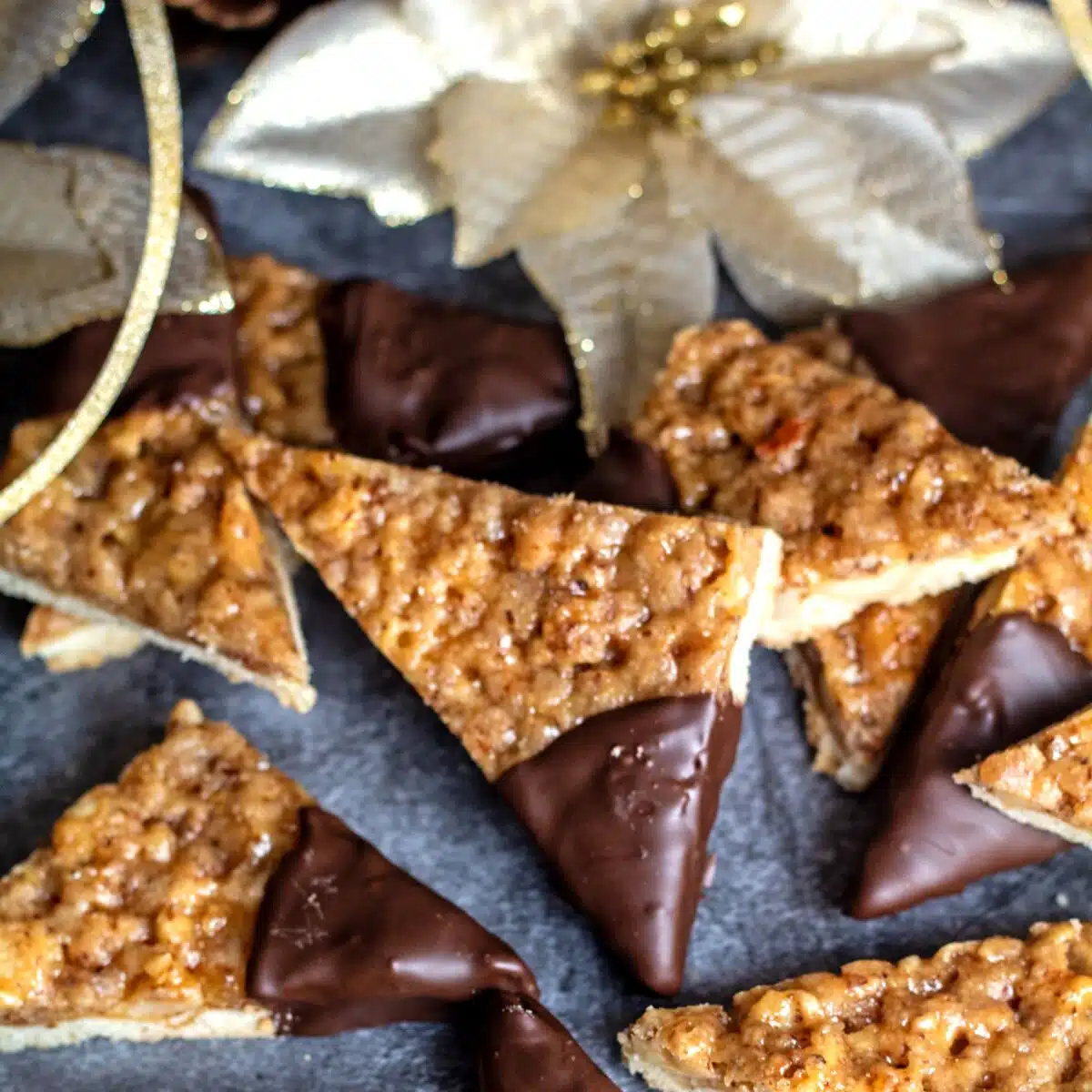
Jump to:
- Add These Flavors of Germany To Your Holiday Baking
- The Most Popular German Christmas Cookies
- 1. Nussecken (German Nut Corners)
- 2. Lebkuchen (German Gingerbread Cookie)
- 3. Pfeffernüsse (German Spice Cookies)
- 4. Vanillekipferl (Vanilla Crescent Cookies)
- 5. Springerle (Anise Cookies)
- 6. Stollenkonfekt (Stollen Biscuits)
- 7. Heidesand (Traditional German Brown Butter Shortbread Cookies)
- 8. Spritzgebäck (German Spritz Cookies)
- 9. Alte Deutsche Honig Plätzchen (Old German Honey Cookies)
- 10. Kardamon Pläetzchen (German Christmas Cardamom Cookies)
- 11. Zimtsterne (Gingerbread Star Cookies)
- 12. Bethmännchen (German Marzipan Cookies)
- 13. Spekulatius (Dutch Windmill Cookies)
- 14. Kifles (German Nut Horns)
- 15. Kokosmakronen (German Coconut Macarons)
- 16. Butterplätzchen (German Butter Cookies)
- 17. Haferflocken Plätzchen (German Oatmeal Cookies)
- 🎄 More Christmas Cookies
- 📖 Recipe Card
- Best Traditional German Christmas Cookies: 17+ Unique & Tasty Cookie Recipes To Bake!
- 💬 Comments & Reviews
Add These Flavors of Germany To Your Holiday Baking
If you like to experiment with your holiday baking each year, why not add some international Christmas cookie recipes? These German Christmas cookies are best homemade; nothing you purchase in a cookie tin can compare!
From soft and crumbly shortbread cookies to chewy oatmeal cookies, there's something here for everyone. In Germany, they love to play with spices and textures, making some downright delicious cookies!
You're sure to love my Italian Christmas cookies collection, too!
The Most Popular German Christmas Cookies
The recipes below are all beloved Christmas cookies from Germany that have been around for years and years! You may find a few variations of each recipe elsewhere, that's because they were often built upon over time as their popularity spread outside the borders of Germany and across Europe.
If you love holiday baking, take a look at my easy Christmas dessert recipes or try following my 25 days of Christmas cookies challenge!
1. Nussecken (German Nut Corners)
Pronounced: Nusseck-en
Nussecken is a buttery shortbread cookie coated with sticky apricot jam, sweet hazelnuts, and a rich chocolate glaze. Oh, did I mention there's rum in them? Because there is!
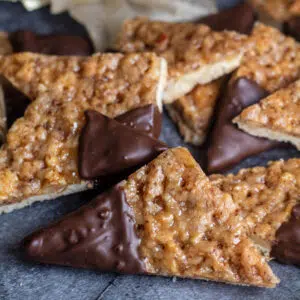
2. Lebkuchen (German Gingerbread Cookie)
Pronounced: Leb-kuh-chn
Lebkuchen is very similar to gingerbread. These sweet but spicy cookies (or sometimes bars) are especially popular around Christmastime.
Their distinguishing characteristic is that they require no flour and are made with hazelnuts and almonds. Use my homemade gingerbread blend for the tastiest cookies ever!
3. Pfeffernüsse (German Spice Cookies)
Pronounced: Fef-fer-nüs-se
The word 'pfeffernüse' translates to pepper nut because they are made with anise, seasonal spices, and black pepper. Pfeffernüse differs from lebkuchen in that it is rolled into a ball and coated with powdered sugar before baking.
:max_bytes(150000):strip_icc()/155182-pfeffernusse-cookies-vat-2X1-3-65476ac846ea4dbbacfe763ce99086c2.jpg)
4. Vanillekipferl (Vanilla Crescent Cookies)
Prounounced: Va-nil-le-kip-ferl
These vanilla crescent cookies will practically melt in your mouth. They are made with ground nuts (almonds, walnuts, or hazelnuts), butter, sugar, flour, and vanilla bean. Their signature flavor comes from a heavy dusting of powdered sugar.
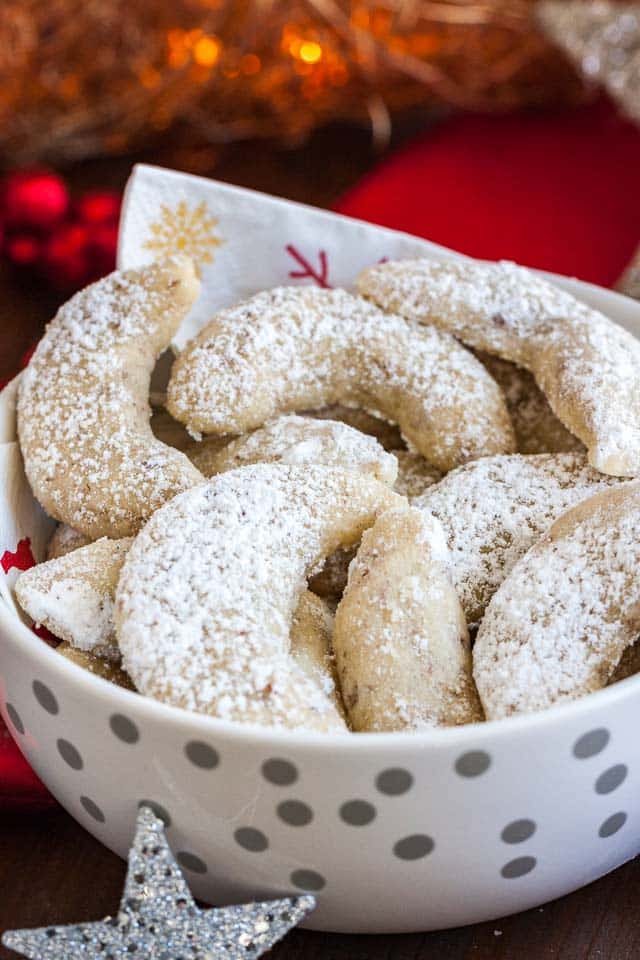
5. Springerle (Anise Cookies)
Pronounced: Sprin-ger-le
Springerle are crispy on the outside with a delightfully chewy center. The name 'springerle' translates to 'little jumpers' because of how these cookies rise or 'jump' while baking.
:max_bytes(150000):strip_icc()/7499595-86990a9c25c5472882f8657e25057bcc.jpg)
6. Stollenkonfekt (Stollen Biscuits)
Pronounced: Staa-luhn-kun-fekt
If you've never tried stollen, you're missing out. It is made by soaking mixed dried fruit and mixed peel in brandy, like a boozy fruit cake. Stollen is just that- a cake, but stollenkonfekt is its bite-sized cookie counterpart!

7. Heidesand (Traditional German Brown Butter Shortbread Cookies)
Pronounced: Hi-deh-sund
These decadent shortbread cookies have their own unique flavor from using browned butter in the batter. It gives the cookies a distinguished taste that is hard to resist.
They may look plain, but I promise you won't miss the frosting on these delicious cookies!

8. Spritzgebäck (German Spritz Cookies)
Pronounced: Shplitz-ghe-beck
Spritzgebäck cookies make a lovely addition to any holiday dessert spread or Christmas cookie tray. They are crisp, buttery, and just slightly sweet, so they balance out the more sugary confections.

9. Alte Deutsche Honig Plätzchen (Old German Honey Cookies)
Pronounced: Al·te Doy·chuh ho-nig plätz-chen
These classic German honey cookies are sweetened with both sugar and honey, though they are not overly sweet. The secret ingredient is ginger, which adds a lovely depth of flavor you don't often expect in a cookie.
:max_bytes(150000):strip_icc()/2241821-7248aac75e8d458791dc86db1d300b6b.jpg)
10. Kardamon Pläetzchen (German Christmas Cardamom Cookies)
Pronounced: Kar-da-mom plätz-chen
Cardamom cookies are a Christmas tradition in Germany. They are fragrant and floral while also a bit salty. To finish things off, the cookies are half-dipped in chocolate, which pairs well with their unique flavor.
:max_bytes(150000):strip_icc()/german-christmas-cookies-cardamom-1446779-hero-01-e15fc3430cd44ab492ee537e2394515c.jpg)
11. Zimtsterne (Gingerbread Star Cookies)
Pronounced: Zimt-ster-ne
These gingerbread star cookies can be found in almost every household around Christmastime. They are light and gluten-free with a touch of nutty spiciness. Not to mention, these cookies are beautiful to look at.
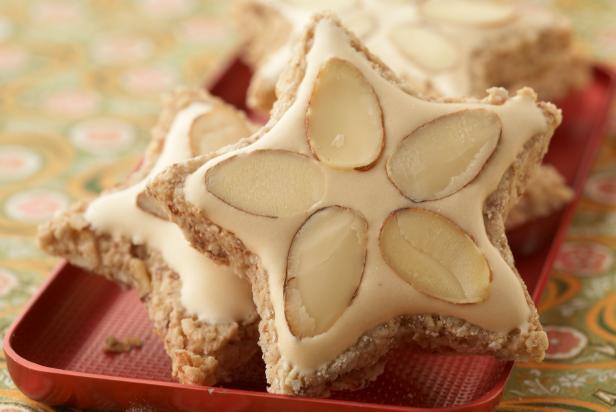
12. Bethmännchen (German Marzipan Cookies)
Pronounced: Beth-männ-chen
Bethmännchen has been a beloved Christmas cookie in Germany for at least 200 years. They include high-quality marzipan, rose water, and almonds. The outside of these cookies is are firm and crisp, while the insides are chewy and soft!

13. Spekulatius (Dutch Windmill Cookies)
Pronounced: Spe-ku-la-ti-us
You can find spekulatius in the United States called 'Dutch windmill cookies.' These cookies are made with cinnamon, cardamom, and cloves, giving them a lovely spiced flavor (clearly, Germans love spiced cookies)!
Traditionally, wooden baking molds are used to achieve their distinct shapes. You may also use silicone baking molds, a molding roll, or cookie cutters in a pinch.
:max_bytes(150000):strip_icc()/german-spice-cookies-spekulatius-recipe-1446782-hero-01-4287b4af633743a08f3a6aeb3251faa1.jpg)
14. Kifles (German Nut Horns)
Pronounced: Kif-fle
These twisted walnut crescent cookies almost look like the horns of an animal, hence the name. They are incredibly popular in Eastern Europe and worldwide, so many countries have their versions.
In Germany, they may be filled with sweet apricots, cranberries, prunes, and/or nuts.

15. Kokosmakronen (German Coconut Macarons)
Pronounced: Ko-kos-m-a-kro-nen
German coconut macarons, or kokosmakronen, are soft and slightly crunchy on the outside. Traditionally, Germans enjoy them without chocolate, though you will often see them dipped in chocolate in other countries (which is still delicious)!

16. Butterplätzchen (German Butter Cookies)
Pronounced: Bu-ter-plätz-chen
Butterplätzchen are easy-to-make butter cookies that work well with cookie cutters. Kids will love to help decorate them by adding sprinkles after you brush them with egg yolk!
You will sometimes see them with lemon icing on top, which is another tasty option.

17. Haferflocken Plätzchen (German Oatmeal Cookies)
Pronounced: Ha-fer-flo-cken plätz-chen
On the outside, these German oatmeal cookies are warm golden brown. On the inside, they are chewy and irresistible!
You can make these cookies with just a handful of standard baking ingredients. Sometimes, simple is a good thing!

Have you tried any of these German Christmas cookies before? Did I miss any of your favorites? Let me know in the comments below!
🎄 More Christmas Cookies
- Polar Bear Paw Print Cookies - Chocolate cookies covered in vanilla frosting and coconut 'fur' with candy paw prints on top!
- Chocolate Blossom Cookies - These double chocolate cookies are always a hit with kids and adults alike!
- Christmas Cookie Gift Box - There's nothing better than a gift you can eat!
- Christmas Gumdrop Cookies - These soft cookies are loaded with chewy gumdrop candies!
- No Bake Pumpkin Cookies - You can whip up a batch of these tasty oatmeal pumpkin cookies without ever turning on your oven.
- Sprinkle Crinkle Cookies - These sweet, soft cookies look like festive snow-covered confetti!
Do you love a recipe you tried? Please leave a 5-star 🌟rating in the recipe card below and/or a review in the comments section further down the page.
Stay in touch with me through social media @ Pinterest, Facebook, Instagram, or Twitter! Subscribe to the newsletter today (no spam, I promise)! Don't forget to tag me when you try one of my recipes!
📖 Recipe Card
Best Traditional German Christmas Cookies: 17+ Unique & Tasty Cookie Recipes To Bake!
Ingredients
Shortbread Base & Apricot Jam
- ½ cup butter (unsalted - softened, at room temperature)
- ½ cup sugar
- 2 large eggs (at room temperature)
- 2 teaspoon vanilla extract
- 1 teaspoon baking powder
- 1 pinch salt
- 2 ½ cups all-purpose flour
- ⅓ cup apricot jam (jam, jelly, or preserves)
Hazelnut Layer
- 1 cup butter (unsalted)
- 5 tablespoon rum (or water)
- 1 cup light brown sugar
- 2 teaspoon vanilla extract
- 1 cup hazelnuts (whole)
- 2 cups hazelnut meal (or almond meal)
Chocolate Glaze
- 1 cup dark chocolate (chopped - or dark chocolate chips)
- 1 teaspoon butter (optional)
(Note: 2x or 3x only changes the ingredient list)
Instructions
Make the Shortbread
- Preheat your oven to 350°F (175°C/Gas Mark 4) and trim a sheet of parchment paper to fit inside a 18x13 rimmed baking sheet. *This is the jelly roll size baking sheet.
- In a large mixing bowl or the bowl of your stand mixer cream the softened ½ cup butter with ½ cup sugar until smooth. Add the 2 large eggs and 2 teaspoon vanilla extract, as well as the 1 teaspoon baking powder and 1 pinch salt then beat until combined.
- Add the 2 ½ cups all-purpose flour and mix in until your flour is fully incorporated into a smooth dough. Transfer the dough to your parchment paper-lined baking sheet and press to fill the baking sheet in an even layer. *You can also roll the dough out between sheets of parchment paper until is close to your pan size, then transfer and finish pressing to fill the baking sheet.
- Dock the entire surface of the shortbread base using the tines of a fork. Then, coat the top of the shortbread pastry dough with a layer of the ⅓ cup apricot jam , jelly, or preserves. *Use a drizzle of warm water to make the jam more spreadable.
Make the Hazelnut Layer
- In a small saucepan, add the 1 cup butter and 5 tablespoon rum (or water), 1 cup light brown sugar, and 2 teaspoon vanilla extract and heat over medium until the sugar is dissolved without bringing the sauce to a boil.
- Chop your 1 cup hazelnuts or crush them in a plastic bag using the flat side of a meat mallet or tenderizer (or anything heavy!) until course in texture.
- Add the chopped hazelnuts and ground 2 cups hazelnut meal to the sauce and mix until combined. Drop onto the shortbread base in large dollops, then spread over the apricot layer using your spatula to push the nut layer over the entire surface in an even layer.
- Bake at 350°F (175°C) for 25-30 nor until light golden brown in color on the edges. Remove from the oven and allow to cool completely overnight, or until the bars reach room temperature and chill in the refrigerator for 2-3 hours to set up completely.
Glaze the Nussecken
- Use a sharp knife to cut the Nussecken into 30 squares, then cut each square in half diagonally to make triangles.
- Melt the 1 cup dark chocolate in a microwave-safe bowl (with optional 1 teaspoon butter if desired) in 30-second increments on high power. Stir between each heating until melted and smooth.
- Dip the corners of each Nussecken into the melted chocolate then place the coated triangles onto a cooling rack or a sheet of parchment paper to set.
Notes
- The flavor is so much more wonderful when you take a few minutes to dry roast the whole hazelnuts before crushing. To do this heat a clean, dry skillet to medium heat and add the hazelnuts. Stir occasionally until lightly toasted and fragrant. Remove from heat and transfer to a clean bowl (and out of the still-hot skillet!).
- Allow toasted hazelnuts to cool for a few minutes before bagging them to crush into 'chopped hazelnuts' size.
- If using raw whole hazelnuts, you can toast or roast to remove the skin. Toast until the skin blisters, then roll the nuts under your palm or rub with a kitchen towel to remove the skin. Alternatively, you can also roast hazelnuts in a single layer on a parchment paper-lined baking sheet at 350°F (175°C) for 10-15 minutes, stir the nuts every 5 minutes while roasting.
- Store at room temperature in an airtight container for up to 3-4 weeks. Keep Nussecken in a single layer, or place parchment paper between layers.

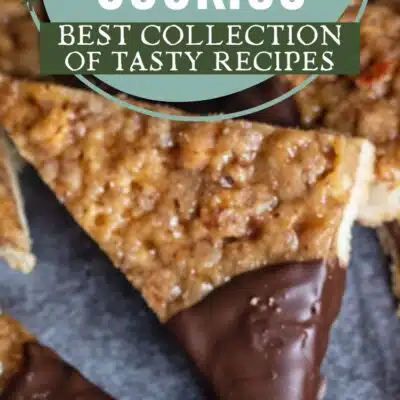
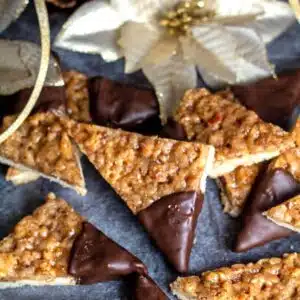
Comments
No Comments